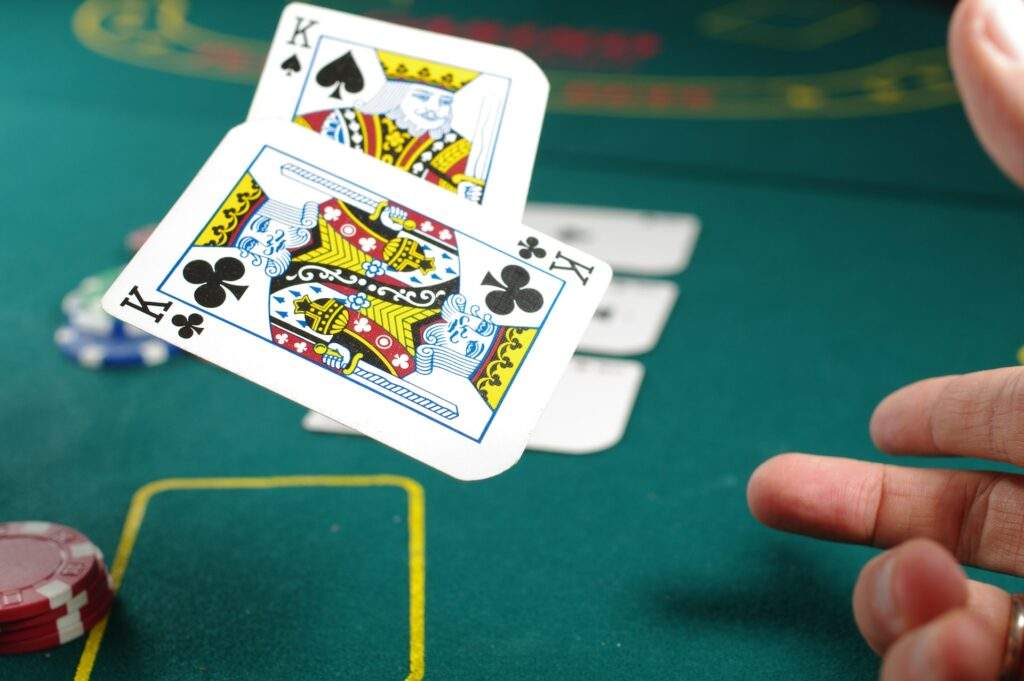Introduction:
Five-Card Draw is a classic and straightforward variant of poker that has stood the test of time. With its simplicity and focus on traditional poker hand rankings, Five-Card Draw provides a nostalgic and enjoyable poker experience. In this article, we delve into the intricacies of Five-Card Draw, exploring its rules, gameplay, and strategies that will help you refine your skills in this beloved variant. Get ready to embrace the elegance of a Five-Card Draw and elevate your poker prowess.
Unlike many other poker variants, in Five-Card Draw the goal is to end with the strongest possible five-card poker hand. This is why understanding and recognizing poker hand rankings is essential to success in this game. Beginners should be sure to familiarize themselves with the varying hand rankings and how they rank about one another. Furthermore, you will need to become aware of the different strategies for drawing additional cards to maximize your chances of achieving a strong hand. Finally, the betting process in a Five-Card Draw is slightly more conservative than other variants, so understanding proper bet sizing and bluffing techniques will be key to victory.
A player must use both their skill and strategy to win at Five-Card Draw poker. Learning the probability of certain hands being drawn, recognizing the different strategies employed by opponents, and knowing how to allocate chips responsibly can be the difference between a win and a loss. Additionally, players must strive to stay mindful of their opponent’s bet sizing, bet patterns, and other mannerisms. Being able to read an opponent’s tells is yet another important component of any successful Five-Card Draw strategy.

Understanding the Basics of Five-Card Draw:
Five-Card Draw follows a simple structure that revolves around drawing and betting. Here are the key elements to grasp:
Initial Deal:
In a Five-Card Draw, each player is dealt five private cards face down. After the deal, a round of betting takes place, starting with the player to the left of the dealer.
Once the first round of betting is complete, players have the option to discard any or all of the cards they are holding and replace them with new ones from the remaining deck. After the cards are redistributed, a second round of betting commences and the players show their hands. Whoever has the best hand wins the pot.
The best hand is usually determined by the rank of the cards; the highest rank is the ace, followed by king, queen, jack, 10, 9, 8, 7, 6, 5, 4, 3 and 2. The winner is then awarded the pot and the game is over.
Drawing Phase:
After the first round of betting, players have the option to discard and replace any number of their cards in exchange for new ones. The objective is to improve the strength of your hand by selecting cards from the deck. Once the drawing phase is complete, there is another round of betting.
After the second round of betting, the remaining players must then show their cards. The highest hand wins the pot and the game is over.
Players who folded during the first two rounds of betting are not required to show their cards. The dealer will then begin the next hand and the game will start again.
Showdown:
If more than one player remains after the final round of betting, a showdown occurs. Players reveal their five-card hands, and the player with the best hand based on traditional poker rankings wins the pot.
The player with the best hand also becomes the last person remaining in the game and is awarded the pot. If two or more players have the same hand, then the pot is split between the players with the best hand. Some variation of poker allows players to make a pending hand by discarding some of their cards in exchange for new cards from the deck. The rules prevailing in the game will determine which hand is better, the pending or regular hand.
In certain cases, players can also make side bets which are independent of the main pot. Players bet on the occurrence of certain hands and if such hands are made by any player, the side bet winner takes the bet. Most commonly the side bet is for the highest hand, but some variations also include bets for the second or third best hand.

Key Strategies for Success:
To excel in Five-Card Draw, consider the following strategies:
Starting Hand Selection:
Starting hand selection is crucial in Five-Card Draw. Begin with a strong initial hand to maximize your chances of improving your hand in the drawing phase. Look for pairs, high-ranking cards, and suited connectors. Avoid starting with weak, disconnected hands that have little potential for improvement.
If possible, try to form an open-ended straight draw, which gives you the highest chance of filling out your straight with any of the four cards you draw. Also, look for playable hands such as an Ace-high, two pairs, or three of a kind, which may be worth betting on. Remember that your starting hand selection should factor in what your opponents might hold. If your opponents look to have strong starting hands, it may be wise to fold a weak hand and potentially cut your losses.
Discard Wisely:
During the drawing phase, carefully evaluate your hand and decide which cards to discard and replace. Consider the strength of your initial hand, the number of opponents, and the potential value of different draws. Discard strategically to increase your chances of forming a strong final hand.
A strong final hand could consist of multiples of the same card or a run of multiple numbers. In addition, look for potential combinations with wild cards that will give you a stronger hand. Sometimes it’s better to hang onto a particular card even if it does not appear strong in the draw. Knowing when to keep a card and when to discard can be a tricky decision that can make or break a game. With practice, you’ll become more familiar with the best practices for evaluating and strategizing your hand during the draw phase.
Observation and Bluffing:
Pay close attention to your opponents’ betting patterns, their discards, and their general demeanor during the game. Look for tells or patterns that indicate the strength or weakness of their hands. Utilize this information to make better decisions, including when to bluff and when to value bet.
Taking the time to analyze your opponents will also help you to learn from your mistakes and become a more successful poker player. Reviewing each hand in which you were involved, looking at past hands played by your opponents, and watching your opponents for betting behaviors will provide the data you need to improve your strategy. Use this data to make better decisions and make more informed plays.
Positional Play:
Position is important in Five-Card Draw, just as it is in other poker variants. Acting later in the betting rounds provides an advantage as you have more information about your opponents’ actions. Utilize your position to make more informed bets, raises, or calls based on the strength of your hand and the actions of your opponents.
In the earlier positions, you can gauge the strength of your opponent’s hands much more easily as there are fewer players in the game and less aggressive betting has taken place. This allows you to make more precise decisions about which starting hands to enter the pot with, and whether or not to stay in after the draw phase. When you are in a late position, you can be more aggressive pre-draw, since you have more information to work from. However, do not get too carried away since this leaves you open to losing a lot of chips if your opponent is bluffing.
Hand Reading:
Develop the ability to read your opponents’ hands based on their betting patterns, discards, and the number of cards they draw. By carefully observing these factors, you can make educated guesses about the range of hands your opponents might have. This skill is crucial for making well-timed bluffs and avoiding costly mistakes.
A well-timed bluff can make all the difference in a game of poker. When you can read your opponents’ hands correctly, it gives you an immense advantage. You can make the best decisions with the most accurate information possible. Knowing what cards your opponent might have in their hand allows you to select the perfect moment for a bluff and trap your opponent into making a mistake. Reading your opponents’ hands is also helpful when deciding how to play certain hands. By understanding their betting patterns, discards, and draws, you are better equipped to make balanced decisions and maximize your chances of winning.

Advanced Strategies:
Once you have mastered the basics, you can explore advanced strategies to further enhance your Five-Card Draw game:
Range Considerations:
Pay attention to the range of hands your opponents might have based on their actions and the cards they draw. Narrow down their possible holdings to make better-informed decisions. This analysis allows you to tailor your betting and make accurate assessments of the strength of your hand.
You can also look at past betting patterns of your opponents to gain useful insights about their playing style. For example, when a player bets and raises quickly, they are often showing a strong hand. Conversely, a passive player might be trying to slow-play a monster hand and lull you into betting. Pay attention to these clues, as they can help inform your decisions. Finally, a good strategy is to check out how your opponents have been playing in earlier rounds of the same hand. Studying how they act in response to various situations can give you valuable insights that you can use to your advantage.
Deception and Mixing Up Play:
To keep your opponents off balance, mix up your play by occasionally deviating from standard strategies. Incorporate deceptive plays, such as occasionally drawing fewer cards than expected with a strong hand or vice versa. This element of surprise can give you an edge and confuse your opponents.
Experiment with bluffing more often as well. Try to convince your opponents that you have a better hand than you do or, conversely, that your hand is weaker than it is. Mastering the art of bluffing is essential for succeeding in poker. Failing to bluff properly can cost you a crucial game as your opponents may not take your plays seriously. To succeed, you must be able to bluff with confidence.
Pot Control:
In Five-Card Draw, controlling the size of the pot is crucial. When holding a strong hand, consider betting and raising to build the pot. Conversely, when your hand is weaker or uncertain, focus on pot control by checking and calling. This strategy helps you avoid committing too many chips and minimizes your losses in unfavorable situations.
One of the biggest mistakes made in a Five-Card Draw is chasing after draws even when the odds of hitting them are slim. Going after a flush or straight draw when there are already multiple opponents in the pot only increases the probability of somebody hitting their draw. Unless you are sure that a flush or straight draw is the winning hand, it is best to fold and save your chips for better opportunities. Knowing when to fold is a key concept in successful Five-Card Draw play.
Bankroll Management:
Implement proper bankroll management to ensure the sustainability of your poker journey. Set aside a dedicated poker bankroll and avoid playing at stakes that exceed your comfort level or risk tolerance. Protecting your bankroll allows you to weather downswings and remain in the game.
Be sure to track your progress and take consistent breaks to ensure you avoid making bad decisions during long playing sessions. Make sure to set session goals each time you play and adjust your strategy accordingly. Monitor your play and adjust your goals regularly to ensure you stay on course. Utilize self-analysis and continually strive to learn new poker strategies to stay at the top of your game. Most importantly, do not forget to have fun and enjoy your poker journey.
Practice, Patience, and Observation:
Becoming proficient in Five-Card drawing requires practice, patience, and keen observation. Here are additional tips to enhance your game:
- Study Hand Rankings: Familiarize yourself with the traditional poker hand rankings. Understanding the hierarchy of hands is fundamental to making accurate assessments of hand strength and determining the value of potential draws.
- Hand Analysis: After each session, review your hands and analyze your decisions. Identify areas where you could have made better choices or missed opportunities. Continually assess your gameplay and seek areas for improvement.
- Bankroll Management: Practice disciplined bankroll management to ensure the longevity of your poker journey. Set aside a dedicated poker bankroll and avoid playing at stakes that exceed your financial capabilities.
- Continual Learning: Poker is a game of constant evolution. Stay updated with the latest strategies, trends, and resources through books, online forums, training sites, and engaging with the poker community. Continual learning and seeking new insights will help you refine your strategies.
- Emotional Control: Maintain emotional control throughout your Five-Card Draw sessions. The game can be unpredictable, and swings can occur. Emotional stability allows you to make rational decisions and avoid tilting, which can lead to poor choices.
Conclusion:
Five-Card Draw offers a classic and refined poker experience that continues to captivate players. By understanding the basics, implementing effective strategies, and continually refining your skills, you can become a formidable player in this beloved variant. Remember to assess starting hands carefully, make strategic discards, observe your opponents closely, and adjust your play based on position and hand reading. With practice, patience, and a love for the game, you can elevate your Five-Card Draw skills and relish the elegance of this timeless poker variant.
Playing Five-Card Draw games can also be a lovable amusement between friends and family. By keeping these competitions friendly and low-stakes, you can create a memorable social experience that will remain in your hearts for years to come. Taking the time to familiarize yourself with the basics, structure, and strategies will help you to quickly adapt and enjoy the game at the intermediate and even expert level. As with any poker, constructing a successful Five-Card Draw strategy requires lots of practice, dedication, and experimentation. With the right skills and a healthy dose of enthusiasm, you can explore the many wonderful aspects of this game with loved ones — or with strangers — at the table.
You may want to start by playing Five-Card Draw with Play Money – virtual money used solely for game-playing purposes. In this way, you can familiarize yourself with the structure of the game and the different stages of betting without risking too much of your own money. This can be an invaluable tool for honing your game and developing the bankroll that you need to jump into higher-stakes games. After you have mastered the basics, you can move on to tournaments and cash games at your leisure. The best part about Five-Card Draw is that it can be as competitive or as laidback as you want it to be – there’s something for everyone.